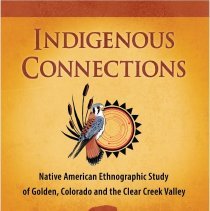Archive Record
Images

Metadata
Object ID |
2022.043.001 |
Title |
Indigenous Connections: Native American Ethnographic Study of Golden, Colorado and the Clear Creek Valley |
Accession number |
2022.043 |
Object Name |
Report |
Scope & Content |
Digital and hardcopy of Indigenous Connections: Native American Ethnographic Study of Golden, Colorado and the Clear Creek Valley. Executive Summary: Native American history and connections to the Clear Creek Valley and table lands of the central Colorado Front Range extend back for more than 12,000 years. Contemporary Native American communities continue to view this place as an aboriginal homeland and a living landscape. However, today's historical narrative of the region largely excludes Indigenous people and their values. To address this disparity, the City of Golden formed a partnership between its division of Planning and Museums, with the additional support of the Historic Preservation Board, to engage Native American tribes and ethnographic researchers to help tell the story of indigenous people in this region. The study involved cultural advisors from six American Indian tribes and a review and synthesis of relevant ethnographic literature. Together, the oral historical and documentary records provide a robust narrative about Native American connections to Colorado's Front Range, and create a foundation for future collaborative research with tribal communities. Situated within the ancestral territory of multiple tribes, the Clear Creek Valley can be understood as a place where multiple Indigenous lifeways were practiced. All of the components that make up this area-including viewsheds, night skies, soundscapes, trails, plants, animals, waterways, landforms, archaeological sites, and historical events-have value and significance to contemporary Native American people. Topography and habitats are some of the indicators of a homeland and cultural landscape to Indigenous people, as they provide physical and spiritual sustenance. The Clear Creek Valley provides an access corridor between the interior Rocky Mountains and the Plains. As an ecological transition zone, over 180 plant species found within the Golden region have documented Indigenous uses and names, and these serve as a foundation for Native American continued use and connections to the area. Ancestral sites have cultural and historical significance related to Indigenous lifeways and values on the landscape. Tribal oral traditions and cultural activities continue to reinforce the long-standing connections tribes have to the region. In the oral histories of the Nu?uchiu (Ute), the area now called the City of Golden is located within the origin places of the Moghwachi?, Tabeguache, and Uncompahgre bands and has been significant since time immemorial. The oral histories and documentary record of the Tséts?hést?hese or Tsistsistas (Cheyenne) and Hinono'ei (Arapaho) reveal a history that began in the eighteenth century or earlier, and encompassed the Front Range of Colorado. Painful tribal histories, including the forced removal of the Utes from a large portion of their ancestral lands, and the removal of the Cheyenne and Arapaho from Colorado following the Massacre at Sand Creek, are historically linked to the development of the City of Golden and are therefore essential components of Native American interpretation of the area. The City of Golden today recognizes that these oral traditions are an integral part to cultural identity and cannot be trivialized. This study should be viewed as the first step in building collaborative and positive relationships between American Indian tribes, the City of Golden, and other Front Range communities. The research presented in this report is viewed as a positive first step by all of the tribes that participated, and they requested further consultation and ethnographic research to ensure their respective traditions and histories are accurately represented in the Clear Creek Valley and along the Front Range of Colorado. |
Search Terms |
Native Americans (Jefferson County, CO) |
Additional Media |
Golden Indigenous Connections Ethnography Report |
